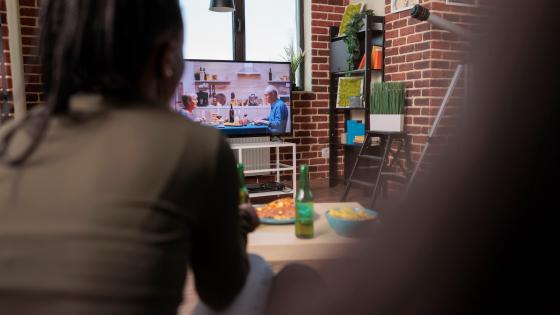Let’s begin on a positive note: in the past decades, the world has become more tolerant towards homosexuality (Pew Research Center 2020). Yet, in Latin America and the Caribbean (LAC) – as in many other places around the world – discrimination based on sexual orientation and gender identity persists. For instance, while Argentina has seen a rise in acceptance of homosexuality from 66% in 2002 to 76% in 2019, more than half the population in Bolivia and El Salvador still believe homosexuality is unacceptable. What determines such beliefs around the LGBQT+ community?
In this column, we explore the influence of TV media representation of LGBTQ+ characters on individuals’ attitudes towards the LGBTQ+ community. According to the parasocial contact hypothesis, when individuals have limited direct contact with minority groups, television can play an important role in shaping viewers’ attitudes towards minority group members (Schiappa et al. 2006). As viewers, we positively react to minority group characters that are relatable and likable (Schiappa et al. 2005, 2007). Likewise, negative portrayals can reinforce prejudices and lead to backlash.
So what exactly is it that we do?
In a paper with Selim Gulesci (Gulesci et al. 2024), we focus on a very specific cultural product of Latin America – telenovelas
– and provide causal evidence on what happens with attitudes towards the LGBTQ+ community once a new telenovela with LGBTQ+ characters goes on air. To do so, we built a novel dataset with information on 175 telenovelas with LGBTQ+ characters that aired in 14 LAC countries between 2002 and 2019. Then, we combine this data with public opinion surveys asking respondents about their approval of homosexuals running for office and their beliefs about whether homosexuality is justifiable. To be able to make a causal statement, we take advantage of the fact that some of those 175 telenovelas aired precisely in the middle of the fieldwork of the public opinion surveys. This allows us to compare the average response of people living in the same country and year who were interviewed shortly before and after the telenovela with LGBTQ+ characters aired.
Data collection and identification
We started off by constructing a database with information on all telenovelas with LGBTQ+ characters that aired during prime time between 2002 and 2019 in Argentina, Bolivia, Brazil, Chile, Colombia, Dominican Republic, Ecuador, El Salvador, Guatemala, Honduras, Mexico, Nicaragua, Peru, and Venezuela. As there are no systematic repositories of telenovela scripts or episodes, we conducted a search using secondary sources such as websites with systematised records on telenovelas with LGBTQ+ characters, news articles on LGBTQ+ characters featured in telenovelas, opinion articles analysing the representation of LGBTQ+ characters in broadcast television, and research papers focusing on the role of LGBTQ+ characters in television shows. Once we identified the soap operas with LGBTQ+ characters, we recorded the period in which the show aired in each country, the TV channel and time of the day in which it aired, whether the show was a comedy or a drama, the number of LGBTQ+ characters featured, the sexual orientation and gender identity of the LGBTQ+ characters, and whether the LGBTQ+ characters were part of the main cast. The average show aired at 8pm for 162 episodes and had two LGBTQ+ characters, most of them homosexual men who belonged to the main cast.
To measure attitudes towards the LGBTQ+ community, we relied on three public opinion surveys that ran in the region between 2002 and 2019: the Latin America Public Opinion Project (LAPOP), the Latinobarómetro, and the World Value Survey (WVS). These are nationally representative surveys conducted periodically throughout LAC.
- In the LAPOP, respondents are asked: “...thinking of homosexuals, how strongly do you approve or disapprove of such people being permitted to run for public office?”
- The Latinobarometro asks: “tell me if you believe that homosexuality can ever be justified or never justified or somewhere in between."
- Likewise, the WVS asks: “... tell me for each of the following actions [homosexuality] whether you think it can always be justified, never be justified, or something in between”
In all surveys, respondents answer on a scale from 1 to 10. With these surveys we were able to attain a sample of 134,540 individual responses on the approval of homosexuals running for office and 71,195 responses on whether homosexuality is justifiable.
Let's go through an example to see precisely how we combine the data. Consider Los Graduados, an Argentinian telenovela that aired on 12 March 2012 and ended on 19 December 2012. In 2012, Argetina’s LAPOP fieldwork ran from 3 March until 4 April, while the WVS ran from 11 to 31 December. Before Los Graduados and since 2002, six telenovelas with an LGBTQ+ character aired in Argentina. Thus, people interviewed by the LAPOP after Los Graduados aired were exposed to one additional telenovela with LGBTQ+ characters. Consequently, they might have different attitudes toward the LGBTQ+ community than LAPOP respondents interviewed before 12 March. This is not the case for respondents of the WVS as, at the time they were interviewed, all respondents had been exposed to the same number of telenovelas with LGBTQ+ characters since 2002.
Figure 1
As with Los Graduados, out of 175 telenovelas, 13 aired just in the middle of the field of the LAPOP (8) or in the middle of the fields of the LatinoBarometro or the WVS (5). These 13 shows airing in 7 different countries give us the necessary variation to pinpoint the short-term causal effect of exposure to soap operas with LGBTQ+ characters on the overall population's attitudes towards the LGBTQ+ community.
What do we find?
The data reveal that, in the short term, people who were interviewed after a telenovela with LGBTQ+ characters went on air were less tolerant toward the LGBTQ+ community. In fact, the approval for homosexuals running for office decreased by 9% (3.6 percentage points out of an average approval of 38.5%), and the justifiability of homosexuality dropped by 14.7% (4 percentage points out of an average justifiability of 27.2%).
So, where is the backlash coming from?
The negative reaction seems to be driven by comedies. Exposure to an additional comedy with LGBTQ+ characters leads to a drop in overall approval of homosexuals running for office and justifiability of homosexuality by 8 and 5 percentage points, respectively. In general, comedies tend to portray LGBTQ+ characters in more stereotypical ways than dramas which may explain why they generate a stronger backlash effect. Yet, since comedies and dramas may differ in other aspects, that may also explain these heterogeneous effects.
A final interesting result is that, although the backlash is stronger for individuals with traditional values (older, living in rural areas, and religious), the negative effect is present across the entire population. In other words, the data shows that even younger people, people living in urban areas, or non-religious people experience a negative short-term response to increased representation.
A few caveats
It is important to emphasise two things. First, our results are only short-term outcomes. Second, the effects include both direct and indirect exposure.
Given that our empirical strategy compares individuals before and after the airing of a soap opera and that the interviews take place during relatively short fieldwork (20 to 40 days, on average), we cannot make any statements about what the long-term effects of the introduction of more soap operas with LGBTQ+ characters could be. It is perfectly plausible that, even if in the short run there is a backlash, in the long term there is an overall improvement in attitudes towards the LGBTQ+ community. With our empirical strategy, we simply cannot measure long-run impacts.
Furthermore, our results do not necessarily imply that direct viewership of telenovelas generates such an effect. Our effects come from exposure, either direct or indirect. Indirect exposure can include conversations with peers, social media, or news coverage. Thus, we cannot disentangle whether it is the LGBTQ+ characters per se or how the media covers the representations of LGBTQ+ characters and their storylines.
Are we the first to find this?
Previous literature has shown that edutainment and soap operas have the power to transform attitudes. In the case of gender attitudes, for instance, Chong and La Ferrara (2009) show that exposure to Rede Globo in Brazil led to an increase in the share of women who are separated or divorced. Similarly, for India, Jensen and Oster (2009) showed that the introduction of cable TV led to a fall in the acceptability of domestic violence toward women, son preference, and fertility, as well as an increase in women’s autonomy. In Uganda, Riley (2022) finds that watching a film with a female role model before a high-stakes national exam leads to higher test scores and lower school dropout, particularly among female students. Unlike these positives, our findings draw attention to the potential adverse effects that entertainment media can have on attitudes toward minorities as, in the short run, the mode of representation may increase discrimination by reproducing and amplifying existing stereotypes.
Editors' note: This column is published in collaboration with the International Economic Associations’ Women in Leadership in Economics initiative, which aims to enhance the role of women in economics through research, building partnerships, and amplifying voices.
References
Chong, A and E La Ferrara (2009), “Television and divorce: Evidence from Brazilian ‘novelas’”, Journal of the European Economic Association 7(2/3): 458–468.
Gulesci, S, M Lombardi and A Ramos (2024), "Telenovelas and attitudes toward the LGBTQ+ community in Latin America", Labour Economics 87, 102488.
Jensen, R and E Oster (2009), “The Power of TV: Cable Television and Women’s Status in India”, Quarterly Journal of Economics 124(3): 1057–94.
Pew Research Center (2020), “The Global Divide on Homosexuality Persists”.
Riley, E (2022), “Role Models in Movies: The Impact of Queen of Katwe on Students’ Educational Attainment”, The Review of Economics and Statistics, 1–48.
Schiappa, E, P B Gregg, and D E Hewes (2005), “The parasocial contact hypothesis”, Communication Monographs 72(1): 92–115.
Schiappa, E, P B Gregg, and D E Hewes (2006), “Can one TV show make a difference? a will & grace and the parasocial contact hypothesis”, Journal of Homosexuality 51(4): 15–37.
Schiappa, E, M Allen, and P B Gregg (2007), “Parasocial relationships and television: A meta-analysis of the effects”, Mass Media Effects Research: Advances through meta-analysis, 301–314.




